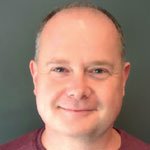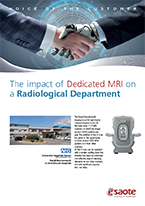Voice of the Customer

Interviews with Dr. Paula McAlinden - MSK Radiologist and with Mr. Matthew Benbow - CT & MRI Superintendent Radiographer at Royal Bournemouth Hospital.
The Royal Bournemouth Hospital is a 650 bed District General Hospital in the UK. We have three 1.5 T MRI scanners on which we image around 18000 patients per year. The addition of the O-Scan has given us the opportunity to move around 3000 MSK patients to it from other scanners. As the O-scan can be operated with a smaller staffing team this initiative has been an extremely cost effective way of releasing demands on our other scanners and add significant capacity into our diary.
Dear Dr. McAlinden, you are a Radiologist at Royal Bournemouth Hospital in which there are different MRI systems installed. What was the key decision to have the O-scan in the Radiology Department of a public hospital? How does the O-scan fit within the department?
The O-scan is one of four MRI scanners in the department, alongside three 1.5 T scanners. The key reason for acquiring it was to help reduce our waiting list by diverting suitable patients from our other scanners into the extremity scanner, freeing up space for more complex examinations. In fact with the increasing pressures and workload coming from MSK referrers, plus more acute scanning coming from the Emergency Department, we were looking for a solution for these generally ambulant patients.
We were hoping to relieve the pressure of the other scanners and the O-scan has allowed us to do this. The other key advantages with the O-scan was the small working space required and the minimal staffing necessary to run it. A good patient experience is also an advantage with the scanner being comfortable with no sense of claustrophobia.
Recently Esaote introduced the new SPED (Spin Echo Dixon) sequence, a fat suppression technique which is very important in the MSK field. How do you evaluate overall image quality and the new SPED?
O-scan image quality is very good and the new SPED sequence has improved it significantly. This has been achieved without significantly increasing our scan times allowing us to maintain efficiency. This has increased the usability of the scanner in MSK, increasing the complexity of the scans that we can achieve.
Where do you think the SPED is clinically important to evaluate MSK pathologies?
The SPED sequence has significantly increased the resolution when compared to the STIR images that we were using previously. This is particularly useful when it comes to assessing articular cartilage in all joints and also for assessing ligaments and tendons.
How do you evaluate the SPED in comparison with the wellknown fatSat sequences of high field?
On our 1.5 T scanners we use PDFS and DIXON techniques in imaging most joints. Using a similar sequence in the O-scan allows increased versatility allowing us to use the extremity scanner to scan joints that we may otherwise have had to scan at higher field strength. The sequence works to the same as the DIXON sequence and is certainly similarly versatile to the PDFS workhorse of MSK MRI.

Dear Mr. Benbow, since the installation of the O-scan, how many radiographers have been working on the system? Did they find it easy to use in daily practice?
We have 28 radiographers here already trained in MRI on standard 1.5 T scanners. After installation we gave all of them training on the O-scan as I was keen that we did not limit who could be assigned to work on this scanner. Perhaps the biggest difference is in the way the patient is positioned and centered, i.e. that it needs to be done accurately from the very beginning. This was a new concept to them, but not difficult to do once they got the hand of the different coils, patient positions and immobilization aids.
As a Radiographer you are in close contact with the patient, what is their overall experience of being scanned on the O-scan? Do they feel comfortable during the MRI exams with the O-scan?
Patient comfort is good, especially for upper limb scanning where the alternative on a 1.5 T is an uncomfortable ‘Superman’ position. Also, claustrophobia is of course never an issue as it is for some patients on traditional MRI scanners. The examination is much quieter, so patients can listen to the radio or even have a snooze. For this reason it is important that the radiographer ensures really good limb support and immobilization at the start of the examination.
Running the O-scan daily and now with the SPED sequences, how have you changed your previous O-scan protocols? And how do you rate the image quality?
The SPED sequence has significantly increased the resolution when compared to the STIR images that we were using previously. This is particularly useful when it comes to assessing articular cartilage in all joints and also for assessing ligaments and tendons.
How do you evaluate the SPED in comparison with the wellknown fatSat sequences of high field?
On our 1.5 T scanners we use PDFS and DIXON techniques in imaging most joints. Using a similar sequence in the O-scan allows increased versatility allowing us to use the extremity scanner to scan joints that we may otherwise have had to scan at higher field strength. The sequence works to the same as the DIXON sequence and is certainly similarly versatile to the PDFS workhorse of MSK MRI.
Contact us for more information
Read other MRI interviews
O-scan MRI at The Hand Clinic, a specialty center located in Amsterdam
An interview with Prof Marco Ritt, plastic surgeon and board certified hand surgeon. Among others: President of the Dutch Hand-surgery association, Examinator Federation of European Societies for Surgery of the Hand, Reviewer Journal of the American Society for Surgery of the Hand.
Magnifico™ Open at Sport Ortho Urgent Care
Brant Bell, MSM, PA-C Founder/VP of Clinical Services, Sport Ortho Urgent Care Sport Ortho Urgent Care is a Nashville-based multi-location provider of comprehensive orthopedic care, offering a wide array of services to treat everything from general musculoskeletal pain to complex fractures, spinal issues, sports, and work-related injuries.
O-scan and S-scan at Genesis Orthopedics & Sports Medicine
Our goal is simple: free our patients to be more active, more athletic, and to move freely in their bodies – accessible to everyone, not just a select few. That our patients, regardless of walk of life, move more freely, function better, and experience life to the fullest.




